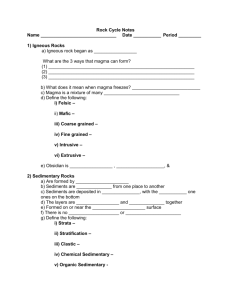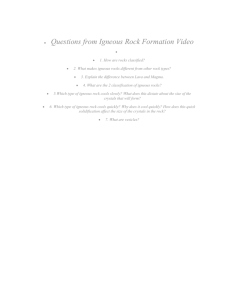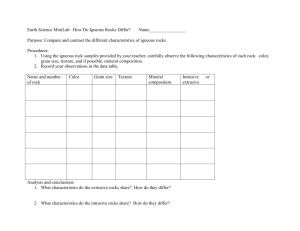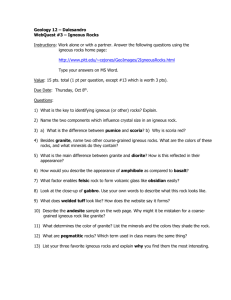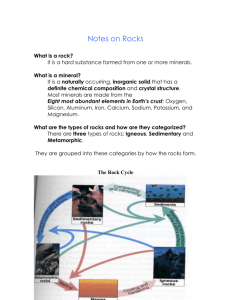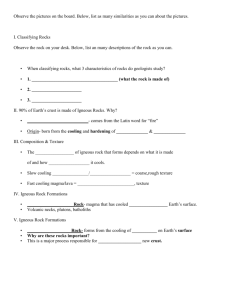Genetic Classification of Igneous Rocks
advertisement
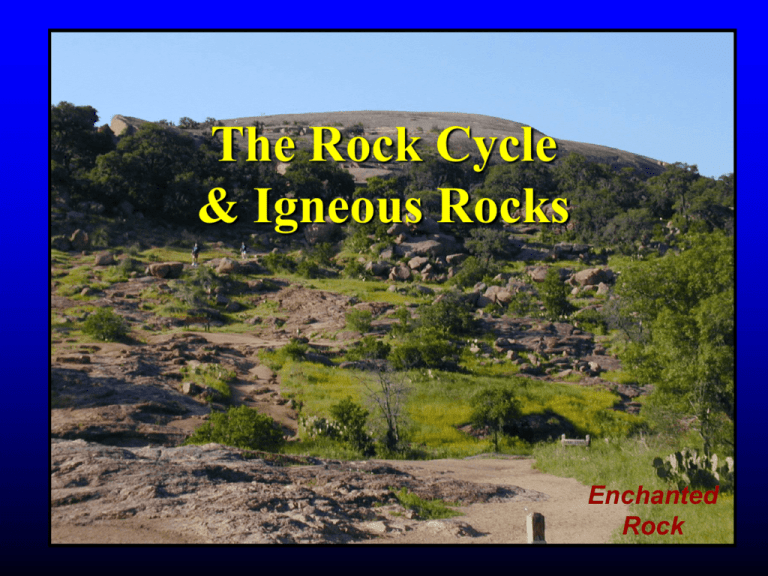
The Rock Cycle & Igneous Rocks Enchanted Rock The Rock Cycle -Melting & Intrusion -Solidification of melt -Mountain Building -Uplift & Exposure -Weathering -Erosion & Transport -Deposition & Burial -Metamorphism -Melting & Intrusion Fig 4.9 Genetic Classification of Igneous Rocks • Intrusive: crystallized from slowly cooling magma intruded within the Earth’s crust; e.g. granite, gabbro. Granite Gabbro The Rock Cycle Extrusive rocks Intrusive rocks Fig 4.9 Rock Texture Fig. 5.1 Intrusive: Course-grained, interlocking Genetic Classification of Igneous Rocks • Extrusive: crystallized from rapidly cooling magma extruded on the surface of the Earth as lava, … Rhyolite Basalt The Rock Cycle Fig 4.9 Rock Texture Fig. 5.1 Intrusive: Course-grained, interlocking Extrusive: Fine-grained, discrete crystals, often glassy Genetic Classification of Igneous Rocks • Extrusive: … erupted as pyroclastic material, i.e., fragmented pieces of magma ejected and cooled in the air. Ash Pumice Scoria Formation of Igneous Rocks Pyroclasts Extrusive Intrusive Porphyry: Fig. 5.3 partially crystalline Composition and Classification of Igneous Rocks • Chemistry: e.g. % SiO2 • Mineralogy: e.g. – Felsic - high silica (continental crust) – Intermediate - intermediate silica – Mafic - low silica (oceanic crust) – Ultramafic - very low silica (mantle) Felsic Igneous Rocks: Igneous rocks rich in minerals high in silica and low in iron and magnesium. They come from thick, slow moving magma. They include: Granite Rhyolite Mafic Igneous Rocks: Igneous rocks rich in minerals low in silica and high in iron and magnesium. They come from magma that is thinner, and faster moving (more fluid). They include: Gabbro Basalt Common Minerals Intermediate Igneous Rocks: Igneous rocks intermediate in composition between felsic and mafic igneous rocks. They include: Granodiorite (Dacite) Diorite (Andesite) Ultramafic Igneous Rocks: Igneous rocks with very low silica content, consisting dominantly of mafic minerals. The most common ultramafic rock is: Peridotite (no extrusive equivalent) Fig. 5.4 Granite Quartz Orthoclase Granite Biotite Plagioclase Compositional Classification Granite Granodiorite Granite Compositional Classification Quartz Amphibole Plagioclase Granite Granodiorite Compositional Classification Diorite Granite Plagioclase Amphibole Granite Granodiorite Compositional Classification Diorite Granite Gabbro Plagioclase Pyroxene Granite Granodiorite Compositional Classification Diorite Granite Gabbro Pyroxene Olivine Peridotite Table. 5.2 Felsic Intermediate Mafic Granite Granodiorite Diorite Gabbro Rhyolite Dacite Andesite Basalt Viscosity Melting Temperature How do magmas form? When rocks melt (or partially melt). When do rocks melt? When the temperature exceeds the melting point of the rock or some minerals within the rock. Factors that Affect Melting of Minerals (and Rocks) • Composition: Felsic minerals melt at lower temperatures than mafic minerals • Pressure: Increased pressures raises melting points • Water Content: Increased water content lowers melting points Magma pools in magma chamber The Formation of Magma Chambers Magma rises Buoyant melt migrates through rock pores and fractures. Less dense magma Partial melting Melt is less dense than solid. Low density minerals tend to melt first. Some minerals melt before others. Results in mixture of melt and solid. Igneous Intrusions… • Plutons are masses of rock that forms when magma cools inside Earth’s interior. • Plutons reach Earth’s surface after uplift and/or weathering exposes them. • Dikes – A sheet of igneous rock that cuts through previously formed rock vertically or at a steep angle. – Can be hundreds of kilometers long, and can range from 1 cm to many meters thick. • Sills – A sheet of igneous rock that lies parallel to the layers it goes through. Forms when magma is forced between, not across rock layers. – Can be hundreds of metters thick, and many km long. • Laccoliths – When magma doesn’t flow in sheets, but bulges upward, creating a dome. • Volcanic Neck – The plug of hardened magma left after the volcanic material around an inactive volcano erodes away. • Batholiths – Largest of all plutons – the ‘core’ of many of Earth’s mountain ranges. – Usually made of either granite or granodiorite, and can be very huge. – A ‘Stock’ is a small exposed section of a small batholith. - Covers 15,400 mi2 !! - Composition - Granite - Monzonite - Granodiorite - Diorite - Even Gneiss - All in one “magma chamber”

